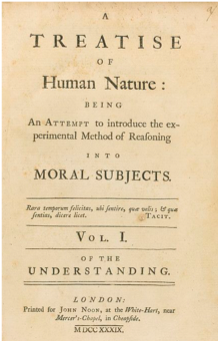Hume 116: Impressions and ideas in the Treatise
You are only required to know what Hume says in the specified extracts from the Enquiry. However, it can be useful to know what Hume says about impressions and ideas in the Treatise which he wrote some years earlier. What he says in the Treatise gives some insight into his thinking and helps stop us making inappropriate criticisms.
In the Treatise he not only says that ideas can be SIMPLE and COMPLEX but so can impressions.
- Simple impressions and simple ideas are such that they cannot be broken down into something smaller.
- Complex impressions and complex ideas can be distinguished into parts. He gives the example of an apple — although a particular colour, taste, and smell, are all united in the apple they are still distinguishable from each other.
He says,
 |
|
So, with complex impressions and ideas there is, in general, a great resemblance between the impression and the corresponding idea but we cannot say that they are always exact copies of each other.
However, with simple impressions and ideas there is a one to one correspondence:
Hume says the idea of red we form in the dark differs only in degree from the impression we receive of red when we see something red in the sunshine.
Since complex impressions and ideas are formed from simple impressions and ideas we can say that, one way or another, impressions and ideas are always correlated.
The next task is to determine which comes first. By simple observation we note that the impression always comes first. If you want to give a child an idea of scarlet or orange, of sweet or bitter, you have to expose them to the relevant impression. It would be daft to try to generate the impression by attempting to first give them the idea.
He notes that if someone, for whatever reason, hasn't had the opportunity to have the relevant impression the corresponding idea will also be absent.
The claim that all our SIMPLE ideas are derived from SIMPLE impressions is now known as ‘the copy principle’, although Hume didn't use this wording.
However, he does then admit the "one contradictory phenomenon" in which a simple idea can precede a simple impression. See The missing shade of blue.
The two things to note from what Hume says in the Treatise are that:
- He believes colours are simple impressions with corresponding simple ideas. This is relevant to the problem of the missing shade of blue. If the colours cannot be broken down into parts then there is nothing for us to manipulate and so we shouldn't be able to generate the new colour. It may just be that Hume is wrong. Perhaps it is the HUE that is the simple impression whereas the shade, tone and tint are complex impressions that can be broken down even if we are not consciously aware of how we do it.
- Although we may generate some complex ideas through our ability to manipulate ideas, there are other complex ideas that are the result of complex impressions.
